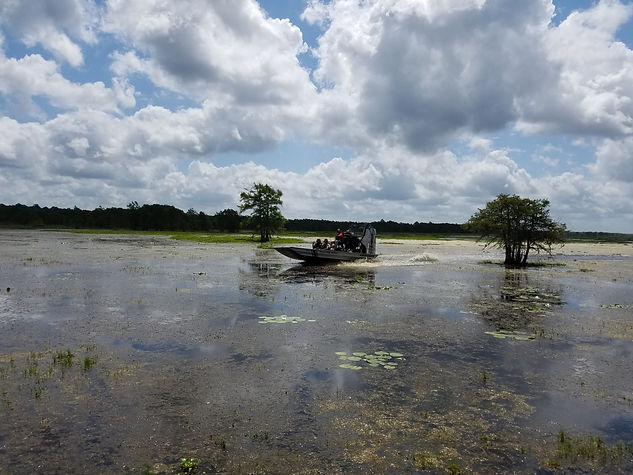

Research, White Papers and Published Articles
The Academy has a number of nationally recognized staff members and subject matter experts in various aspects of maritime public safety, port security, infrastructure protection, training, policy, technology, manufacturing, design, and exercise, to name but a few. We are often engaged by local, state, federal, military and private sector partners, domestically and internationally, to conduct research, assessments, evaluations, and consultation. And our relationships with renowned institutions like Florida State University, Louisana State University, Mercyhurst University, University of South Florida, etc., enable our research capabilities to expand exponentially to the officers, agencies, and organizations we serve.
Some samples of our work are provided here. To learn more about how these services and resources can help you, your agency and your region, contact us today by clicking here. We look forward to assisting you to enhance your capabilities and the safety and security of our Nation's waterways.
A SMARTER Approach to Maritime Security: Part 2- Port Digitization and MARSEC Accreditation
Back in March of 2017, the NMLEA had released a White Paper titled A SMARTER Approach to Maritime Security[1], and in it, we spoke about how we can look at the Maritime Transportation System (MTS) with all its parts, (the ports with all of the complexities and nuances, the public safety professionals protecting that domain and its 30 million workers[2], and the private sector trying to manage its functions and services) and explore how we can work together to solve some of the problems we face by providing “Security Solutions through the Maritime [Accreditation] Alliance for Research, Technology, Training, Exercises, Education, Equipment and Resources,” otherwise known as a “SMARTER” Approach.
In a new White Paper released in January of 2022, we introduce an actual application of that SMARTER Approach to Maritime Security. It will show you how we can come together, and implement a program that will Increase the Readiness and Resiliency of our ports and maritime infrastructure through the creation of a National Digital Library, Enhance our Security Capabilities while dramatically Reducing the Costs of security regulatory compliance-related expenses (Vulnerability Assessments, Training, Exercises, and Cybersecurity Maturity).
INTEREST IN POLICE PATROL CAREERS - An Assessment of Potential Candidates’ Impressions of the Police Recruitment, Selection, and Training Processes
Following an NMLEA webinar done with Dr. Charles Scheer from the University of Southern Mississippi, "The Future of Law Enforcement - What You Need to Know," the Technical Report that he referenced and the survey results are now available for download and review. You can find a copy of the report by clicking here.
The Preface of the report is here and explains the motivation for the survey, and the results it revealed.
In the spring of 2017, Chief Leonard Papania of the Gulfport (MS) Police Department and I began a conversation regarding the persistence of a crisis in the recruitment of police personnel, addressing the difficulty police agencies of varying size and jurisdictional character were having in generating basic interest in police careers. The well-publicized “cop crunch”, as discussed in previous police literature, was not going away despite the apparent economic recovery from the 2008 recession and its aftermath. Why, we wondered, despite the robust and increasing numbers of entry-level positions in police patrol, was the career of police patrol work such a “hard sell” with the current potential applicant pool? Also, why were some of those very individuals seemingly interested in specialized police work (e.g., detective or investigator, K9 officer, narcotics officer) but averse to patrol officer positions? Were these potential applicants fearful of the selection process (i.e., invasive background investigations and social media oversight)? Were these people deterred from police patrol careers because of the perception that the initial training expectations were too rigorous (i.e., academy physical training and the challenge of attending a lengthy academy)?
Another consideration which grew out of this conversation was the potential inability or failure of police agencies to possibly address basic recruit expectations, namely assistance with the application process, realistic job preview, and mentoring. We considered the oneway police application process that had existed for decades, of agencies which recruited by providing application information, and the lack of potential applicants who were interested enough in the career to walk through the proverbial open door. Now that the door was flung wide open, and the applicants were few, what was the source of the continuing challenge? Was it “fear points” on the part of candidates, or the reluctance of police recruiters to embrace the recruiting process which was now reversed, that of candidates recruiting the agency, not the way it had been for generations?
Our interest in resolving this dilemma led to a basic research agenda and project idea. Chief Papania had been a guest lecturer at The University of Southern Mississippi (of which he is an alumnus) for several years, and he proposed a series of roundtable discussions allowing college students (representing a sample of potential candidates) to share their opinions and impressions of police careers, the recruitment, selection, and training processes, and what their potential “fear points” were regarding a patrol career. I began to itemize a list of these possible “fear points” through consultation with not only existing college students but also recent graduates and then-current patrol officers and academy cadets. A survey instrument which focused on numerous potential barriers to police patrol career interest was developed, grouped by venue (the recruitment and selection processes, the training academy) and by group of interest (pressure from family and friends, community and peer expectations, and more global impressions of one’s role within the contemporary police population). I asked Dr. Michael Rossler of Illinois State University to assist me with the project because of his interest in police organizational management. In the fall of 2017 we distributed the survey to five undergraduate institutions in their criminal justice courses, in order to capture not only potential criminal justice majors but also students who may have a passing interest in police careers. In the spring of 2018 we began to analyze the data, which serves as the basis for many of the discussions, conclusions, and suggestions for police recruitment strategy here.
We hope that this report and its findings will illuminate previously-misunderstood features of the police recruitment process, especially in an era when police practitioners are continually challenged to adapt to the existing pool of career applicants in crafting police officers of future generations.
The Business Case for Cyber Risk Management in the Maritime Domain
Among the many opportunities to reduce costs related to managing cyber risks across an organization, managing the costs of cyber risk insurance is emerging as another significant consideration when looking forward. According to the Economist, “Demand for cyber-insurance is growing fast. Satisfying it will pose great challenges for insurers.” Organizations are re-considering their cybersecurity strategy due to several factors;
-
The financial and legal consequences of a breach are increasing.
-
The acceleration of cyber threats, including the growing pace and scale of attacks mean organizations cannot stand still.
-
The steady growth of the digitally connected enterprise (e.g. IoT), also known as the “Attack Surface” is dramatically increasing cyber risk.
-
Increasing end-point, perimeter security tools, or additional compliance-based activities are often ineffective at reducing cyber risk, and
-
Organizations are looking for business-case rationale to help drive better cybersecurity strategies.
And with spending forecasts projecting global cybersecurity spending to exceed $124 Billion in 2019, the questions most often asked are: What should our budget priorities be? Hire or contract with cybersecurity experts? Purchase more scanners and cyber security software? Read this White Paper to explore how and why implementing a Cyber Risk Management program is emerging as the leading investment for a number of important strategic and business reasons.
TACTICAL BEHAVIOR SCIENCE SKILLS: Changing the Law Enforcement Landscape and Preventing Violent Encounters
Law Enforcement personnel are facing challenges unique to any other time in history, as explored in our previous White Paper: Navigating the Seascape of Change in Maritime Public Safety. In this paper we will look at the People part of the 4’Ps (People, Platforms, Process and Performance) and specifically why advanced training is critical for officers to recognize nonverbal signals of aggression and how this training can provide them with behavioral tactics that can enhance citizen compliance, dramatically impacting violent outcomes that have been occupying headlines across the country.
"No Safe Harbors:" Charting A Smarter Course with Cyber Risk Management
Can organizations truly build a defensive shield big enough and strong enough to ensure protection? The quick answer is “no.” You will never stop the attacks, and if you focus on putting up a good wall or guards at the barbed wire fence, someone will always be working on a plan to get around all that. If your cybersecurity plan is solely focused on the defenses you put up, someone will get by the gatekeepers. So, what do you do? Especially when you consider we are all suffering some degree of “cyber fatigue.”
"Navigating the Changing Seascape of Maritime Public Safety"
A look at the all the change factors that are contributing to the challenges of the maritime law enforcement, public safety, and emergency response domain, and how government organizations, state and local agencies, and private sector providers, can navigate through the evolving seascape of the 4 P's: People, Platforms, Processes and Performance.
A SMARTER Approach to America's Maritime Security
Imagine the possibilities if maritime security in America was addressed cooperatively through an alliance in areas of Research, Technology, Training, Exercises, Education and Resources. If federal agencies, private sector vendors, manufacturers, educational institutions, research organizations, exercise, training and consulting firms all came together to work under one umbrella, one banner, one name. The white paper will outline a SMARTER approach to not only America’s maritime security, but any nation’s or port’s security. You are invited to explore and imagine the possibilities for you, your organization, and your country.
Training Challenges: Adjusting to Incoming and Outgoing Tides
Article printed in April 2016 Small Craft Advisory Magazine and in the January 2017 Caribbean Maritime Magazine.
In this ever-evolving world in which we live, change is a constant. Change in climate, in leadership, in policies, in culture, in recruits, in technology, in connectivity and social media. I’m sure we can have a storytelling session on each of those areas and how it has affected each of you because each of those areas impact you as a maritime law enforcement officer, emergency responder or public safety official. It effects what you do, how you do it, who you do it with, and what you can and can’t do with and the tools you use to do your job. This, in turn, puts additional pressure on us as maritime professionals to keep up with change, let alone get ahead of it. It is cumbersome and challenging to keep up with what is the latest and greatest (the incoming tide) and recognize what is yesterday’s tactic, technique or procedure (the outgoing tide.)
Intelligence Forward. Thinking (and Seeing) Ahead
This paper, published in 2008, looks at how intelligence programs are being built, and back in time to see what intelligence gave us and what we failed to do, and try to figure out why. This paper will get you to at least look outside your box (paradigm), if not think outside it, in order to improve and enhance your chance for success and the security of the place we call our homeland. The answer, the "silver bullet" as it relates to developing intelligence programs for your unit, department or agency will be provided at the end of the paper. It will reveal the ultimate sensor that you can turn on today and begin collecting critical intelligence tomorrow.
Homeland Security and the Green Line Behind It
Published in 2011, this paper looks at how Fish and Wildlife, Natural Resource and Game Warden Law Enforcement Officers are an important and critical layer of the United States’ Homeland Security System.









